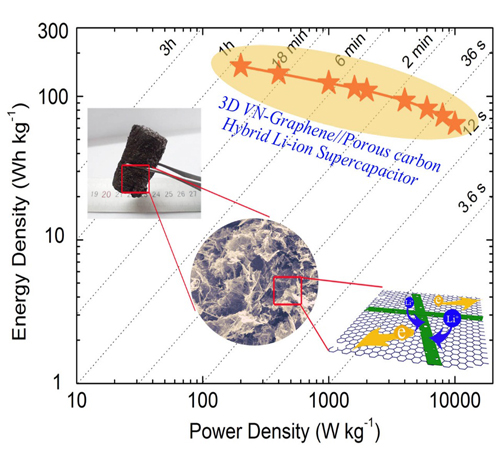Li-ion hybrid capacitors (LIHCs), consisting of an energy-type redox anode and a power-type double-layer cathode, have attracted significant attention due to their combination of the advantages of conventional Li-ion batteries and supercapacitors. However, most anodes are battery-like materials with the sluggish kinetics of Li-ion storage, which seriously restricts the energy storage of LIHCs at the high charge/discharge rates.
The research group headed by Professor YAN Xingbin at the Lanzhou Institute of Chemical Physics of the Chinese Academy of Sciences has developed a HLIC by coupling a 3D VN(vanadium nitride)–RGO(reduced graphene oxide) anode and a porous carbon rod cathode for the first time.
This hybrid device has a high working voltage window up to 4V owing to the wide range of Li-ion intercalation/detercalation voltage (0.01–3 V vs Li/Li+) of VN–RGO. Furthermore, VN–RGO//APDC(activated polyaniline-derived carbon) HLIC can deliver a high energy density of≈162 Wh kg−1at 200 W kg−1. Even at a high power density of 10 kW kg−1, VN–RGO//APDC HLIC can still deliver≈64 Wh kg−1.
The researchers have demonstrated that VN nanowire has obvious pseudocapacitive characteristic of Li-ion storage and can get further gains in energy storage through a 3D porous architecture with the assistance of conductive RGO. Due to the unique 3D porous structure of VN–RGO composite, it exhibits much better charge storage and rate capability compared with pure VN nanowires.
The results presented here indicate that designing a 3D porous VN–RGO composite with pseudocapacitive characteristics is an effective approach to boost the energy and power densities of hybrid supercapacitors .

Ragone plots of 3D VN–RGO//APDC and VN//APDC HLICs as well as APDC//APDC symmetric supercapacitor. (Image by YAN Xingbin et al.)
The findings have been published inAdv. Funt. Mater.(Adv. Funt. Mater., DOI: 10.1002/adfm.201404472).
The work has received support from the National Defense Basic Research Program of China and the National Nature Science Foundations of China (Grant No. 21203223).
Key words:composites; grapheme; porous carbon; supercapacitors; vanadium nitride
Contact : YAN Xingbin
Laboratory of Clean Energy Chemistry and Materials, State Key Laboratory of Solid Lubrication, Lanzhou Institute of Chemical Physics, Chinese Academy of Sciences, Lanzhou,
E-mail: xbyan@licp.cas.cn

